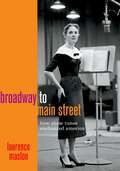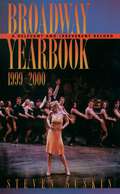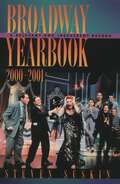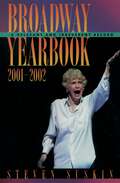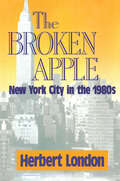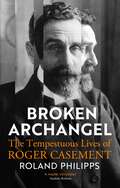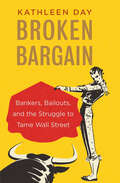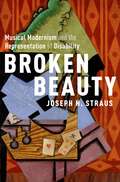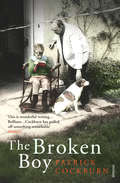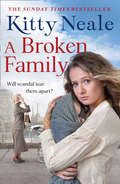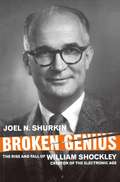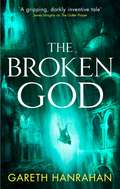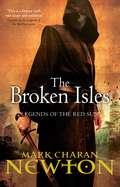- Table View
- List View
Broadway to Main Street: How Show Tunes Enchanted America
by Laurence MaslonThe music of Broadway is one of America's most unique and popular calling cards. In Broadway to Main Street: How Show Tunes Enchanted America, author Laurence Maslon tells the story of how the most beloved songs of the American Musical Theater made their way from the Theater District to living rooms across the country. The crossroads where the music of Broadway meets popular culture is an expansive and pervasive juncture throughout most of the twentieth century--from sheet music to radio broadcasts to popular and original cast recordings--and continues to influence culture today through television, streaming, and the Internet. The original Broadway cast album--from the 78 rpm recording of Oklahoma! to the digital download of Hamilton--is one of the most successful, yet undervalued, genres in the history of popular recording. The challenge of capturing musical narrative with limited technology inspired the imagination of both the recording industry and millions of listeners: between 1949 and 1969, fifteen different original cast albums hit number one on the popular music charts, ultimately tallying more weeks at number one than all of the albums by Frank Sinatra, Elvis Presley, and The Beatles combined. The history of Broadway music is also the history of American popular music; the technological, commercial, and marketing forces of communications and media over the last century were inextricably bound up in the enterprise of bringing the musical gems of New York's Theater District to living rooms along Main Streets across the nation. Featuring new interviews with Stephen Schwartz, Chita Rivera, Steve Lawrence, and prominent record producers and music critics, the story of this commercial and emotional phenomenon is told here in full--from the imprimatur of sheet music from Broadway in the early 20th century to the renaissance of Broadway music in the digital age, folding in the immense impact of show music on American culture and in the context of the recording industry, popular tastes, and our shared national identity. A book which connects cherished cultural artifacts to the emotional narratives at the core of American popular music, Broadway to Main Street: How Show Tunes Enchanted America is an ideal companion for all fans of American musical theater and popular music.
Broadway to Main Street: How Show Tunes Enchanted America
by Laurence MaslonThe music of Broadway is one of America's most unique and popular calling cards. In Broadway to Main Street: How Show Tunes Enchanted America, author Laurence Maslon tells the story of how the most beloved songs of the American Musical Theater made their way from the Theater District to living rooms across the country. The crossroads where the music of Broadway meets popular culture is an expansive and pervasive juncture throughout most of the twentieth century--from sheet music to radio broadcasts to popular and original cast recordings--and continues to influence culture today through television, streaming, and the Internet. The original Broadway cast album--from the 78 rpm recording of Oklahoma! to the digital download of Hamilton--is one of the most successful, yet undervalued, genres in the history of popular recording. The challenge of capturing musical narrative with limited technology inspired the imagination of both the recording industry and millions of listeners: between 1949 and 1969, fifteen different original cast albums hit number one on the popular music charts, ultimately tallying more weeks at number one than all of the albums by Frank Sinatra, Elvis Presley, and The Beatles combined. The history of Broadway music is also the history of American popular music; the technological, commercial, and marketing forces of communications and media over the last century were inextricably bound up in the enterprise of bringing the musical gems of New York's Theater District to living rooms along Main Streets across the nation. Featuring new interviews with Stephen Schwartz, Chita Rivera, Steve Lawrence, and prominent record producers and music critics, the story of this commercial and emotional phenomenon is told here in full--from the imprimatur of sheet music from Broadway in the early 20th century to the renaissance of Broadway music in the digital age, folding in the immense impact of show music on American culture and in the context of the recording industry, popular tastes, and our shared national identity. A book which connects cherished cultural artifacts to the emotional narratives at the core of American popular music, Broadway to Main Street: How Show Tunes Enchanted America is an ideal companion for all fans of American musical theater and popular music.
Broadway Yearbook, 1999-2000: A Relevant and Irreverent Record (Broadway Yearbook)
by Steven SuskinBroadway Season 1999-2000 is a unique and detailed guide to the theatrical year presenting 46 different shows. The volume features a comprehensive discussion of every show that opened on Broadway during the 1999-2000 season as well as several non-Broadway productions of importance or general interest. Each entry is accompanied by credits and cast lists, scorecards summarizing overall critical reception for each show, and a recap of each show's financial performance. A new kind of theatre annual, this distinctive volume discusses what the shows are actually like (instead of merely relying on plot synopses or photographs). It is an interpretive record, featuring not only dates and names but also the stories behind the statistics. Opening night title pages illustrate each show discussion. Appendices include a roundup of the season's major awards, memorable performances of the year, obituaries, long run leaders, shows still running from prior seasons, scheduled shows that never reached Broadway, and a comprehensive index. Steven Suskin has provided a relevant and irreverent record of the year's memorable high points (and low points). Written from an insider's perspective, the book is knowledgeable, intriguing, provocative, and entertaining.
Broadway Yearbook 2000-2001: A Relevant and Irreverent Record (Broadway Yearbook)
by Steven SuskinBroadway Yearbook 2000-2001 is a relevant and irreverent record of the theatrical year. A vivid album of the year on the Great White Way, Broadway Yearbook gives readers front-row seats for the phenomenon of The Producers and the rest of the season's hits and misses. Steven Suskin's acclaimed new theatre annual delivers a vibrant, candid, and thoughtful account of every show to hit the boards: exciting musicals such as The Full Monty and the revival of 42nd Street; intriguing new plays like Proof and The Tale of the Allergist's Wife; and fascinating failures, including Jane Eyre and the beleaguered Seussical. Broadway Yearbook tells us what the shows were actually like. It is an interpretive record, featuring not only dates and names but also the stories behind the statistics. Each entry is accompanied by credits and cast lists, scorecards summarizing overall critical reception for each show, a summary of each show's financial performance, and copies of the illustrative program covers and title pages. Appendices provide a roundup of the season's major awards, memorable performances of the year, obituaries, long run leaders, shows still running from prior seasons, scheduled shows that never reached Broadway, and a comprehensive index. Steven Suskin has provided a unique and detailed record of the season's memorable moments and high points (and low points as well). Written from an insider's perspective, the book is knowledgeable, intriguing, provocative, and entertaining. Broadway Yearbook brings the shows of the 2000-2001 season back for an encore.
Broadway Yearbook 2001-2002: A Relevant and Irreverent Record (Broadway Yearbook)
by Steven SuskinCalled the "theater equivalent of longtime New Yorker film critic Pauline Kael" by Matinee Magazine, critic and producer Steven Suskin chronicles the 2001-2002 theater season in his latest installment in the Broadway Yearbook series. Commenting with wit and erudition on each show that opened on Broadway between May 2001 and May 2002, Suskin's vivid descriptions recall Tony winners like Thoroughly Modern Millie and Urinetown and commercial smashes like Mamma Mia! and The Graduate. A great read for theater buffs, the book is also a valuable sourcebook for critics, Broadway historians, and theater professionals, providing an array of statistics on every Broadway production of the season, as well as noteworthy off-Broadway performances. The intelligent and witty Broadway Yearbook, 2001-2002 will engage theater lovers, performers, and critics alike.
The Broca-Wernicke Doctrine: A Historical and Clinical Perspective on Localization of Language Functions
by Geert-Jan RuttenThis book discusses theories that link functions to specific anatomical brain regions. The best known of these are the Broca and Wernicke regions, and these have become synonyms for the location of productive and receptive language functions respectively. This Broca-Wernicke model has proved to be such a powerful concept that is remains the predominant view in modern clinical practice. What is fascinating, however, is that there is little evidence for this strictly localist view on language functions. Modern neuroscience and numerous clinical observations in individual patients show that language functions are represented in complex and ever-changing neural networks. It is fair to say that the model is wrong, and that Broca’s and Wernicke’s areas in their classic forms do not exist. This is a fascinating paradox: why do neurologists and neurosurgeons continue to use these iconic language models in everyday decision-making? In this book, the author uses his background as a neurosurgeon and a neuroscientist to provide some answers to this question. The book acquaints clinicians and researchers with the many different aspects of language representation in the brain. It provides a historical overview of functional localisation, as well as insights into the misjudgements that have kept the localist doctrine alive. It creates an awareness of the need to integrate clinical observations and neuroscientific theories if we want to progress further in clinical language research and patient care.
The Broken Apple: New York City in the 1980's
by Herbert I. LondonOn the brink of bankruptcy in the 1970s, New York City has been restored as a center of economic and cultural vitality in the 1980s. But it has also become an increasingly brutal place, where incivility reigns, drugs lace the streets, and crime is so pervasive that most New Yorkers now consider it a permanent fixture, like gray skies and impossible traffic. What is it that continues to draw people to this city of contradictions?Born and educated in New York, Herbert London knows this city of dreams as few do. The Broken Apple is based on his keen observations of New York's social, political, and cultural life over the critical decade of the 1980s. London examines the city's continuing failures, including a city administration unable to meet the most basic citizen needs or to assure safety and security. He sees schools that have become mean-spirited, with teachers unable to teach, administrators unable to maintain order, and students unable to learn. He describes the new slaves of New York as those in search of a place to live, in a city where housing is in shorter supply than in any other major city in the nation. London asks why, despite all this, everything is bigger than life in New York, and finds the answer in New York's role as the nation's communications hub and the measuring rod by which other cities are judged.London writes with knowledgeable affection about this very special place, where the mundane is freely converted into the metaphorical. His book is an excursion, a guide to what is good, what is bad, and what is awful in the city. It is a montage of the years of Mayor Koch, the period many have described as the city's fin de siecle. But it is also a perscriptive book, pointing out what can be done in practical ways to improve life.The Broken Apple will be of interest to urban specialists as well as those for whom New York is an aspiration or a reality. Like the city itself, the book has something for everyone, from visions of political corruption to acts of redemption. Above all, it captures the pulsating rhythm of this unique city
The Broken Apple: New York City in the 1980's
by Herbert I. LondonOn the brink of bankruptcy in the 1970s, New York City has been restored as a center of economic and cultural vitality in the 1980s. But it has also become an increasingly brutal place, where incivility reigns, drugs lace the streets, and crime is so pervasive that most New Yorkers now consider it a permanent fixture, like gray skies and impossible traffic. What is it that continues to draw people to this city of contradictions?Born and educated in New York, Herbert London knows this city of dreams as few do. The Broken Apple is based on his keen observations of New York's social, political, and cultural life over the critical decade of the 1980s. London examines the city's continuing failures, including a city administration unable to meet the most basic citizen needs or to assure safety and security. He sees schools that have become mean-spirited, with teachers unable to teach, administrators unable to maintain order, and students unable to learn. He describes the new slaves of New York as those in search of a place to live, in a city where housing is in shorter supply than in any other major city in the nation. London asks why, despite all this, everything is bigger than life in New York, and finds the answer in New York's role as the nation's communications hub and the measuring rod by which other cities are judged.London writes with knowledgeable affection about this very special place, where the mundane is freely converted into the metaphorical. His book is an excursion, a guide to what is good, what is bad, and what is awful in the city. It is a montage of the years of Mayor Koch, the period many have described as the city's fin de siecle. But it is also a perscriptive book, pointing out what can be done in practical ways to improve life.The Broken Apple will be of interest to urban specialists as well as those for whom New York is an aspiration or a reality. Like the city itself, the book has something for everyone, from visions of political corruption to acts of redemption. Above all, it captures the pulsating rhythm of this unique city
Broken Archangel: The Tempestuous Lives of Roger Casement
by Roland PhilippsPioneering human rights campaigner, patriot, romantic, traitor, LGBTQ+ martyr: this is the story of Roger Casement, one of the 20th century’s most complex and compelling figures.'A book of meticulous sensitivity and research' TELEGRAPH'Superbly written, genuinely exciting' ANDREW ROBERTS'Outstanding' JOHN PRESTONIn 1904, Casement became internationally celebrated for unearthing the grotesque violence of the Belgian Congo. Soon after he won even greater renown and a knighthood for his humanitarian work deep in the Amazon jungle.But his internal fault lines ran deep: neither fully Irish nor English, baptised both Protestant and Catholic, desperate for love but forbidden intimacy, betrayed in his only significant relationship, he was of the English diplomatic establishment yet an outsider who fought for Irish nationhood. His final act in wartime Berlin – a doomed scheme to promote an invasion of Ireland – overwhelmed him. And while his subsequent trial for treason brought him some resolution, it also took him to an unmarked prison grave.Casement was a contradictory figure made fallible by contemporary mores and his own unexamined emotions. Only decades later did an Irish state funeral finally assert his nobility above his notoriety – and only now can we fully understand his surprisingly modern and deeply relevant life and legacy.'In Roland Philipps [Casement] has found the biographer he deserves' MICHELA WRONG, author of Do Not Disturb'Vivid, poignant and hugely moving' HENRY HEMMING, author of Our Man in New York
Broken Bargain: Bankers, Bailouts, and the Struggle to Tame Wall Street
by Kathleen DayA history of major financial crises—and how taxpayers have been left with the bill In the 1930s, battered and humbled by the Great Depression, the U.S. financial sector struck a grand bargain with the federal government. Bankers gained a safety net in exchange for certain curbs on their freedom: transparency rules, record-keeping and antifraud measures, and fiduciary responsibilities. Despite subsequent periodic changes in these regulations, the underlying bargain played a major role in preserving the stability of the financial markets as well as the larger economy. By the free-market era of the 1980s and 90s, however, Wall Street argued that rules embodied in New Deal–era regulations to protect consumers and ultimately taxpayers were no longer needed—and government agreed. This engaging history documents the country’s financial crises, focusing on those of the 1920s, the 1980s, and the 2000s, and reveals how the two more recent crises arose from the neglect of this fundamental bargain, and how taxpayers have been left with the bill.
Broken Beauty: Musical Modernism and the Representation of Disability
by Joseph N. StrausPreeminent music theorist and leader in the study of music and disability Joseph Straus presents a truly groundbreaking take on musical modernism--demonstrating in an expansive and vivid multimedia presentation that modernist music is inextricably entwined with attitudes toward disability. In Broken Beauty, Straus argues that the most characteristic features of musical modernism--fractured forms, immobilized harmonies, conflicting textural layers, radical simplification of means in some cases, and radical complexity and hermeticism in others--can be understood as musical depictions of disability conditions, including deformity/disfigurement, mobility impairment, madness, idiocy, and autism. Against the traditional medical model of disability, which sees it as a bodily defect requiring diagnosis and normalization or cure, this new sociocultural model of disability sees it as cultural artifact, something that is created by and creates culture. Straus places this revised model of disability against a wide range of canonical, high-art concert music from the first decades of the century through the 1950s. Broken Beauty illustrates how disability is right at the core of musical modernism; it is one of the things that musical modernism is fundamentally about.
Broken Beauty: Musical Modernism and the Representation of Disability
by Joseph N. StrausPreeminent music theorist and leader in the study of music and disability Joseph Straus presents a truly groundbreaking take on musical modernism--demonstrating in an expansive and vivid multimedia presentation that modernist music is inextricably entwined with attitudes toward disability. In Broken Beauty, Straus argues that the most characteristic features of musical modernism--fractured forms, immobilized harmonies, conflicting textural layers, radical simplification of means in some cases, and radical complexity and hermeticism in others--can be understood as musical depictions of disability conditions, including deformity/disfigurement, mobility impairment, madness, idiocy, and autism. Against the traditional medical model of disability, which sees it as a bodily defect requiring diagnosis and normalization or cure, this new sociocultural model of disability sees it as cultural artifact, something that is created by and creates culture. Straus places this revised model of disability against a wide range of canonical, high-art concert music from the first decades of the century through the 1950s. Broken Beauty illustrates how disability is right at the core of musical modernism; it is one of the things that musical modernism is fundamentally about.
The Broken Boy
by Patrick CockburnIt is very easy to get polio. Patrick Cockburn was six when he woke up one day in the summer of 1956 with a headache and a sore throat. His parents, Claud and Patricia Cockburn, had recently returned to Ireland, to their house in East Cork, careless of the fact that a polio epidemic had broken out in Cork City. He caught the disease and was taken to the fever hospital. The virus attacks the nerves of the brain and the spinal cord leading to paralysis of the muscles. Patrick could no longer walk. The Broken Boy is at once a memoir of Patrick Cockburn's own experience of polio, a portrait of his parents, both prominent radicals, and the story of the Cork epidemic, the last great polio epidemic in the world.
The Broken Branch: How Congress Is Failing America and How to Get It Back on Track (Institutions of American Democracy Series)
by Thomas E. Mann Norman J. OrnsteinCongress is the first branch of government in the American system, write Thomas E. Mann and Norman J. Ornstein, but now it is a broken branch, damaged by partisan bickering and internal rancor. The Broken Branch offers both a brilliant diagnosis of the cause of Congressional decline and a much-needed blueprint for change, from two experts who understand politics and revere our institutions, but believe that Congress has become deeply dysfunctional. Mann and Ornstein, two of the nations most renowned and judicious scholars of government and politics, bring to light the historical roots of Congress's current maladies, examining 40 years of uninterrupted Democratic control of the House and the stunning midterm election victory of 1994 that propelled Republicans into the majority in both House and Senate. The byproduct of that long and grueling but ultimately successful Republican campaign, the authors reveal, was a weakened institution bitterly divided between the parties. They highlight the dramatic shift in Congress from a highly decentralized, committee-based institution into a much more regimented one in which party increasingly trumps committee. The resultant changes in the policy process--the demise of regular order, the decline of deliberation, and the weakening of our system of checks and balances--have all compromised the role of Congress in the American Constitutional system. Indeed, Speaker Dennis Hastert has unabashedly stated that his primary responsibility is to pass the president's legislative program--identifying himself more as a lieutenant of the president than a steward of the house. From tax cuts to the war against Saddam Hussein to a Medicare prescription drug benefit, the legislative process has been bent to serve immediate presidential interests and have often resulted in poorly crafted and stealthily passed laws. Strong majority leadership in Congress, the authors conclude, led not to a vigorous exertion of congressional authority but to a general passivity in the face of executive power. A vivid portrait of an institution that has fallen far from the aspirations of our Founding Fathers, The Broken Branch highlights the costs of a malfunctioning Congress to national policymaking, and outlines what must be done to repair the damage.
Broken Cities: A Historical Sociology of Ruins
by Martin DeveckaWe have been taught to think of ruins as historical artifacts, relegated to the past by a catastrophic event. Instead, Martin Devecka argues that we should see them as processes taking place over a long present. In Broken Cities, Devecka offers a wide-ranging comparative study of ruination, the process by which monuments, architectural sites, and urban centers decay into ruin over time. Weaving together four case studies—of classical Athens, late antique Rome, medieval Baghdad, and sixteenth-century Mexico City—Devecka shows that ruination is a complex social process largely contingent on changing imperial control rather than the result of immediate or natural events. Drawing on literature, legal texts, epigraphic evidence, and the narratives embodied in monuments and painting, Broken Cities is an expansive and nuanced study that holds great significance for the field of historiography.
Broken Cities: A Historical Sociology of Ruins
by Martin DeveckaWe have been taught to think of ruins as historical artifacts, relegated to the past by a catastrophic event. Instead, Martin Devecka argues that we should see them as processes taking place over a long present. In Broken Cities, Devecka offers a wide-ranging comparative study of ruination, the process by which monuments, architectural sites, and urban centers decay into ruin over time. Weaving together four case studies—of classical Athens, late antique Rome, medieval Baghdad, and sixteenth-century Mexico City—Devecka shows that ruination is a complex social process largely contingent on changing imperial control rather than the result of immediate or natural events. Drawing on literature, legal texts, epigraphic evidence, and the narratives embodied in monuments and painting, Broken Cities is an expansive and nuanced study that holds great significance for the field of historiography.
Broken Genius: The Rise and Fall of William Shockley, Creator of the Electronic Age (Macmillan Science)
by J. ShurkinThis is the first biography of William Shockley, founding father of Silicon Valley - one of the most significant and reviled scientists of the 20th century. Drawing upon unique access to the private Shockley archives, veteran technology historian and journalist Joel Shurkin gives an unflinching account of how such promise ended in such ignominy.
The Broken God: Book Three of the Black Iron Legacy (The Black Iron Legacy)
by Gareth HanrahanENTER A CITY OF DRAGONS AND DARKNESSThe Godswar has come to Guerdon, dividing the city between three occupying powers. A fragile armistice holds back the gods, but other dangerous forces seek to exert their influence. Spar Idgeson, once heir to the brotherhood of thieves has been transformed into the living stone of the new city. But his powers are failing and the criminal dragons of the Ghierdana are circling. Meanwhile, far across the sea, Carillon Thay - once a thief, a saint, a god killer; now alone and powerless - seeks the mysterious land of Khebesh, desperate to find a cure for Spar. But what hope does she have when even the gods seek vengeance against her?Praise for the Black Iron Legacy:'Hanrahan is now one of my favourite authors. I flat out adore this series' Booknest'I will buy any novel that Gareth Hanrahan ever writes . . . I want [this series] to go on forever' The Fantasy Inn'Hanrahan has an astonishing imagination' Peter McLean, author of Priest of Bones'Mind-blowingly stellar in every respect . . . Fantasy readers, be wise and buy this book, because there's simply nothing like it' Novel Notions on The Gutter PrayerThe Black Iron LegacyThe Gutter PrayerThe Shadow Saint The Broken God
A Broken Hallelujah: The Making of a Christian Brother
by Lorcan LeavyA Broken Hallelujah traces a young man’s path through the Christian Brothers’ regime from Juniorate through the Leaving Certificate year to Teacher Training, and from there to work ‘on the mission’. The author describes in intimate detail the experiences and challenges he faces on the way, culminating in the final and most difficult decision of all, whether or not to remain in the fold of the Brothers’ Congregation. This unique story recalls a type of education which has long since passed out of use, and has become, for many, a piece of history in itself. In detailing his experiences, the author describes the dilemmas faced by a great number of people, dilemmas which reflect many of the choices and difficulties that have shaped the Ireland of today.
Broken Hearts: The Tangled History of Cardiac Care
by David S. JonesStill the leading cause of death worldwide, heart disease challenges researchers, clinicians, and patients alike. Each day, thousands of patients and their doctors make decisions about coronary angioplasty and bypass surgery. In Broken Hearts David S. Jones sheds light on the nature and quality of those decisions. He describes the debates over what causes heart attacks and the efforts to understand such unforeseen complications of cardiac surgery as depression, mental fog, and stroke.Why do doctors and patients overestimate the effectiveness and underestimate the dangers of medical interventions, especially when doing so may lead to the overuse of medical therapies? To answer this question, Jones explores the history of cardiology and cardiac surgery in the United States and probes the ambiguities and inconsistencies in medical decision making. Based on extensive reviews of medical literature and archives, this historical perspective on medical decision making and risk highlights personal, professional, and community outcomes.
Broken Hearts: The Tangled History of Cardiac Care
by David S. JonesStill the leading cause of death worldwide, heart disease challenges researchers, clinicians, and patients alike. Each day, thousands of patients and their doctors make decisions about coronary angioplasty and bypass surgery. In Broken Hearts David S. Jones sheds light on the nature and quality of those decisions. He describes the debates over what causes heart attacks and the efforts to understand such unforeseen complications of cardiac surgery as depression, mental fog, and stroke.Why do doctors and patients overestimate the effectiveness and underestimate the dangers of medical interventions, especially when doing so may lead to the overuse of medical therapies? To answer this question, Jones explores the history of cardiology and cardiac surgery in the United States and probes the ambiguities and inconsistencies in medical decision making. Based on extensive reviews of medical literature and archives, this historical perspective on medical decision making and risk highlights personal, professional, and community outcomes.
The Broken House: Growing up under Hitler
by Horst Krüger'Exquisitely written... haunting... Few books, I think, capture so well the sense of a life broken for ever by trauma and guilt' - Sunday Times'An unsparing, honest and insightful memoir, that shows how private failure becomes national disaster' - Hilary MantelIn 1965 the German journalist Horst Krüger attended the Auschwitz trial in Frankfurt, where 22 former camp guards were put on trial for the systematic murder of over 1 million men, women and children. Twenty years after the end of the war, this was the first time that the German people were confronted with the horrific details of the Holocaust executed by 'ordinary men' still living in their midst. The trial sent Krüger back to his childhood in the 1930s, in an attempt to understand 'how it really was, that incomprehensible time'. He had grown up in a Berlin suburb, among a community of decent, lower-middle-class homeowners. This was not the world of torch-lit processions and endless ranks of marching SA men. Here, people lived ordinary, non-political lives, believed in God and obeyed the law, but were gradually seduced and intoxicated by the promises of Nazism. He had been, Krüger realised, 'the typical child of innocuous Germans who were never Nazis, and without whom the Nazis would never have been able to do their work'.This world of respectability, order and duty began to crumble when tragedy struck. Krüger's older sister decided to take her own life, leaving the parents struggling to come to terms with the inexplicable. The author's teenage rebellion, his desire to escape the stifling conformity of family life, made him join an anti-Nazi resistance group. He narrowly escaped imprisonment only to be sent to war as Hitler embarked on the conquest of Europe. Step by step, a family that had fallen under the spell of Nazism was being destroyed by it. Written in accomplished prose of lingering beauty, The Broken House is a moving coming-of-age story that provides an unforgettable portrait of life under the Nazis. Yet the book's themes also chime with our own times - how the promise of an 'era of greatness' by a populist leader intoxicates an entire nation, how thin is the veneer of civilisation, and what makes one person a collaborator and another a resister.
The Broken Isles: Legends Of The Red Sun: Book Four (Legends of the Red Sun #4)
by Mark Charan NewtonFleeing refugees and enigmatic heroes, The Broken Isles is the fourth book in Mark Charan Newton's Legends of the Red Sun fantasy series. War spills into the Boreal Archipelago, as two rival cultures bring their eternal battle into this adjacent realm. Fresh from a military victory, Commander Brynd Lathraea plans to rebuild the city of Villiren, where he is confronted with a dilemma. There are friendly forces who have no other choice but to live alongside his own people, and their numbers will be required to fight in the looming conflict. The commander turns politician as he seeks to build bridges and embrace mysterious new technologies to further his ambitions. However, many in Villiren are sceptical of aliens coming to their city, tensions run high, and even the dream of a peaceful future brings with it inevitable clashes of beliefs. Meanwhile, Villjamur has been destroyed. A vast swathe of refugees from the legendary city are now on the run from an immense alien presence in the sky. Villages are being cleared and people are dying en masse. And Inquisitor Fulcrom finds himself at the helm of an operation to aid the refugee exodus to the coast, but it's a race against time before this threatened genocide is complete. Ancient civilisations line up on the field of battle. Exotic creatures and a possible god walk alongside citizens of the Empire. As the Legends of the Red Sun series draws to a close, there will be one final and immense conflict to decide the fate of multiple cultures forever.
